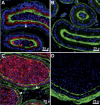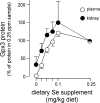Glutathione peroxidase-3 produced by the kidney binds to a population of basement membranes in the gastrointestinal tract and in other tissues
- PMID: 21493731
- PMCID: PMC3280860
- DOI: 10.1152/ajpgi.00064.2011
Glutathione peroxidase-3 produced by the kidney binds to a population of basement membranes in the gastrointestinal tract and in other tissues
Abstract
Glutathione peroxidase-3 (Gpx3), the extracellular glutathione peroxidase synthesized largely in the kidney, binds to basement membranes of renal cortical epithelial cells. The present study assessed extrarenal expression of Gpx3 using RT-PCR and presence of Gpx3 protein using immunocytochemistry. Gpx3 expression was higher in kidney and epididymis than in other tissues. Gpx3 bound to basement membranes of epithelial cells in the gastrointestinal tract, the efferent ducts connecting the seminiferous tubules with the epididymis, the bronchi, and type II pneumocytes. It was not detected on the basement membrane of type I pneumocytes. Gpx3 was also present in the lumen of the epididymis. Transplantation of Gpx3(+/+) kidneys into Gpx3(-/-) mice led to Gpx3 binding to the same basement membranes to which it bound in Gpx3(+/+) mice but not to its presence in the epididymal lumen. These results show that Gpx3 from the blood binds to basement membranes of specific epithelial cells and indicate that the cells modify their basement membranes to cause the binding. They further indicate that at least two Gpx3 compartments exist in the organism. In one compartment, kidney supplies Gpx3 through the blood to specific basement membranes in a number of tissues. In the other compartment, the epididymis provides Gpx3 to its own lumen. Tissues other than kidney and epididymis express Gpx3 at lower levels and may supply Gpx3 to other compartments.
Figures








References
-
- Avissar N, Finkelstein JN, Horowitz S, Willey JC, Coy E, Frampton MW, Watkins RH, Khullar P, Xu YL, Cohen HJ. Extracellular glutathione peroxidase in human lung epithelial lining fluid and in lung cells. Am J Physiol Lung Cell Mol Physiol 270: L173–L182, 1996 - PubMed
-
- Avissar N, Ornt DB, Yagil Y, Horowitz S, Watkins RH, Kerl EA, Takahashi K, Palmer IS, Cohen HJ. Human kidney proximal tubules are the main source of plasma glutathione peroxidase. Am J Physiol Cell Physiol 266: C367–C375, 1994 - PubMed
-
- Avissar N, Slemmon JR, Palmer IS, Cohen HJ. Partial sequence of human plasma glutathione peroxidase and immunologic identification of milk glutathione peroxidase as the plasma enzyme. J Nutr 121: 1243–1249, 1991 - PubMed
-
- Björnstedt M, Xue J, Huang W, Åkesson B, Holmgren A. The thioredoxin and glutaredoxin systems are efficient electron donors to human plasma glutathione peroxidase. J Biol Chem 269: 29382–29384, 1994 - PubMed
-
- Burk RF, Early DS, Hill KE, Palmer IS, Boeglin ME. Plasma selenium in patients with cirrhosis. Hepatology 27: 794–798, 1998 - PubMed
Publication types
MeSH terms
Substances
Grants and funding
LinkOut - more resources
Full Text Sources
Miscellaneous

